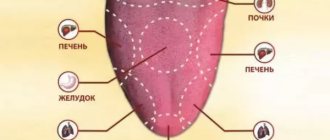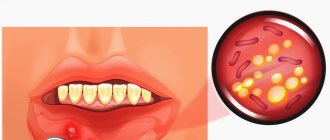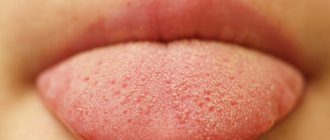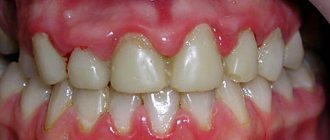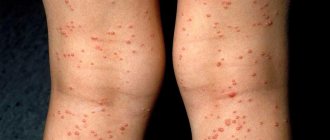The tongue of a healthy person should be matte, pale pink. A slight bloating upon waking, which goes away after eating, is also normal. Sometimes a blue coating is observed and there can be many reasons for this. The most harmless is food coloring added to food.
Also, some types of berries eaten can change color. But the reasons are much more serious, for example, the development of diseases affecting the stomach, liver and other internal organs.
If the tongue gradually darkens even more, then this indicates that the state of health is only getting worse.
Properties of plaque
In order to competently organize independent monitoring of the condition of the tongue to identify signs of incipient diseases on its surface, you need to know what factors and indicators you need to focus on.
Blue coating on the tongue - reasons
- The color has a fairly wide range of variations: transparent, white, yellowish, brown, gray. A red, green, crimson, or black tint may also appear. In children, it often turns out that the bright color was caused by a felt-tip pen that was in the mouth. It could be a caramel cockerel, a drink, or chewing gum. Therefore, before you panic, trying to understand why the child has a blue tongue, it is necessary to analyze the diet preceding this event. Adults experience color changes after drinking coffee, and smoking also contributes to this.
- There are several different types of plaque depending on the texture:
- dry;
- homogeneous;
- wet;
- oily;
- dense;
- loose.
- Sediment thickness is one of the key parameters. If upon visual examination it turns out that the plaque has increased in intensity and the pinkish lingual surface is practically not visible through it, control over the condition of the body should be strengthened. If the picture persists for 24 hours, it is advisable to apply for an appointment for examination.
- Localization of a spot of clearly defined deposits on a certain area of the tongue makes it possible to determine the location of the pathological focus in the body.
- The ease of removing plaque shows the degree of its pain. The normal translucent layer is peeled off during morning hygiene measures and does not appear throughout the day. Deposits that appear due to malfunctions in the functioning of specific systems are not completely removed, but after some time they become even thicker and acquire a color tone characteristic of the underlying disease.
The plaque in a healthy person is transparent and whitish in color. It does not block the view of the tissue of the tongue, is easy to clean, and has no odor. May be slightly yellowish in winter.
Symptoms
Macroglossia can be true or false. Sometimes abnormal development of the jaw arch is mistaken for an increase in lingual tissue. In case of recession or congenital narrowness of the jaw, this ailment is considered false. With true macroglossia, the tongue is enlarged by one and a half to two times. However, this form of the disease occurs rarely.
Macroglossia in newborns
It is important to identify this disease in a timely manner, as this will greatly affect the success of its treatment and the likelihood of it becoming chronic.
Therefore, it is especially important to identify such pathology during the neonatal period.
When examining a newborn, it is important not to miss such manifestations of the disease as:
- enlargement of the tongue when it protrudes beyond the mouth;
- “varnished” or dried surface;
- tuberosity, enlarged papillae;
- blocking of the larynx by the root of the tongue, which forces the baby to refuse food;
- slightly open mouth;
- labored breathing;
- excessive salivation;
- frequent attacks of asphyxia (breathing problems);
- frequent infection and increased body temperature;
- deterioration of general condition.
Very often, children in the first year of life experience a local form of the disease. Often tongue pathology occurs in the fetus for the following reasons:
- improper development;
- idiopathic diseases with symptoms of hypertrophy of the lingual muscles;
- the formation of cysts or cavities during the formation of the tongue muscles;
- with adverse factors affecting the pregnant woman’s body (intoxication, radiation, infections).
Reasons for the formation of blue plaque
It is advisable to collect and analyze all cause-and-effect manifestations that allow us to solve the problem of why a person’s tongue is blue, in order to notice important signals in time. This shade may appear if there is trouble in the heart area. The localization of this color on the lower surface indicates circulatory disorders aggravated by cardiopulmonary failure.
What to do if a blue coating appears on the tongue
A bluish tint on the tongue appears with scurvy. It may also reflect insufficient blood circulation. For a specialist, this may be evidence of poisoning by mercury or other heavy metals. If a blue coating on the tongue suddenly appears on the edges of the tongue located in front of the pharynx, the reasons lie in the kidney area. This kind of indicator can warn of a serious illness. Blue-black spots disappear only after the functioning of the adrenal glands in producing hormones is normalized.
The bluish upper plane becomes an accurate sign of the onset of the development of cardiovascular failure without the presence of other symptoms such as pain, a feeling of oppressive heaviness, and weakness. This will allow you to carry out a set of preventive measures to prevent a heart attack.
What is it needed for
In Dark Souls 3, a pale tongue will be needed for several things at once:
- Increase your level in the Fingers of the Rosary covenant.
- Receiving the Key to the hall with the lift for the battle with the dark spirit from Leonhard. To do this, you must have at least 1 pale tongue in your inventory.
- Changes in the appearance and parameters of Rosaria, the mother of rebirth in the Temple of the Deep.
For this reason, if you want to do one of the things listed above, you need to find an artifact somewhere. We'll talk about this a little below.
Types of plaque that appears on the tongue
The variety of plaques that appear on the lingual surface has its own explanation, based on their characteristic outlines, color shades, and localization.
- The entire tongue is covered with a dense whitish coating with a simultaneous increase in temperature - an infectious disease.
- White deposits appeared in the middle of the tongue with the simultaneous appearance of cracks on the sides - pathological changes in the intestines or stomach. At the first manifestations, it is advisable to follow an easily digestible diet without fatty and salty foods. If you feel pain, you should immediately undergo an examination and obtain medical advice.
- Deposits with a white tint in the anterior area are pathological manifestations in the respiratory system, one of the causes of which may be smoking.
- White spots of deposits all over the tongue are a fungal infection that occurs from the development of dysbacteriosis. Often a consequence of uncontrolled use of antibiotics.
- The presence of a spotted plaque of red and white color is an alarming signal, since the symptoms of scarlet fever often appear. Modern medicine has effective methods for curing this insidious disease; the main thing is to seek help in time.
- The yellowish tint of deposits in small quantities should not cause concern. But with their significant thickness and intensity, we can draw a conclusion about possible inflammatory foci of the gallbladder. If at the same time you begin to worry about pain on the right side under the ribs, you should be examined to diagnose cholecystitis.
- A gray tint of plaque indicates problems in the gastrointestinal system, including increased acidity due to malfunctions that lead to dehydration and disruption of the microflora.
- The transformation of plaque into a brown crust can warn of food poisoning. If there are few deposits, it is worth analyzing the diet to identify products that can color them brownish (chocolate, coffee, cocoa, strong tea). A non-disappearing plaque like this may indicate dysbacteriosis.
The black color of the deposits should alert you, as this may be a sign of the disease entering a critical phase.
Therapeutic diet
Regardless of what the cause of the cyanotic organ of taste is, the first thing you need to do is normalize your diet. The following should be excluded from the diet:
- food from fast foods,
- fatty meats (lamb, pork, duck),
- spicy and salty,
- marinades and smoked meats,
- carbonated drinks,
- alcoholic drinks,
- flour and sweet,
- mushrooms.
You need to eat often, but little by little. Make sure that the intestines are emptied in a timely manner. You need to drink at least two liters of still water per day.
The diet menu should include the following products:
- vegetables (except legumes),
- lactic acid,
- vegetarian soups,
- porridge (wheat, rice, buckwheat),
- non-sour fruits and berries,
- dietary meat (rabbit, turkey, chicken breast).
Causes of plaque in a child
Daily examination of the internal lining of the oral cavity should become a mandatory procedure. A light thin whitish layer on the tongue that disappears after hygiene procedures or eating is normal. If the whiteness does not disappear during the day, and the layer of plaque thickens, it can be assumed that the baby has a common fungal infection, usually called thrush.
Why is there a blue coating on the tongue?
If this disease is not treated promptly, painful ulcers will develop, which will make the child worry and cry. Whitish rashes also appear during colds, disappearing after recovery. Indigestion and vomiting paralleled by a whitish coating should alert parents and prompt them to immediately obtain a qualified medical opinion, as this could be gastritis.
A child’s blue tongue requires special attention, one of the key indicators that can reflect a number of pathological problems in various important sectors of the body:
- respiratory system;
- heart (angina pectoris, arrhythmia);
- circulatory system;
- kidneys
Babies who cannot yet speak cannot express the discomfort that arises from incipient diseases, and parents do not always know how to correctly identify the child’s crying as a consequence of the pain experienced. Therefore, any signal should serve as the beginning of close observation and, if deviations are detected, immediate contact with doctors. Often, a blue tongue in an infant is associated with disorders of the nervous system, accompanied by convulsions and disruptions in the functioning of the cerebral circulation.
Carrying out diagnostics
It is best to diagnose macroglossia in utero. Currently, with ultrasound of the fetus, norms for the size of any of its organs at various stages of pregnancy have been developed. There are optimal sizes for the length and width of the tongue. Often, during intrauterine examination, protrusion of the tongue outside the mouth is noticeable.
The final conclusion is given by specialists after several ultrasound examinations over 1 – 2 months.
More often, a full diagnosis can be established only by the 30th week of pregnancy.
After the birth of a baby with this pathology, he will need a number of consultations with an ENT doctor, an infectious disease specialist, a geneticist, an endocrinologist, and an oncologist.
And only after a detailed examination (using clinical analysis and instrumental methods) is a treatment plan for the disease developed.
Ways to cleanse your tongue
To clean the surface of the tongue from the plaque that forms, it is not necessary to use complex techniques. Regular, affordable devices will do.
- The toothbrush may not have a special rough lining on the inside, oriented to directly carry out a thorough cleansing of thin normal deposits while simultaneously massaging the tongue. It is enough to walk with medium soft bristles with or without antibacterial paste in the direction from the root to the lips, as well as across the tongue to grab the side surfaces.
- You can purchase a special scraper. It is usually made of plastic, although metal or wood products are also available. Some scrapers are supplemented with special brushes.
If necessary, use reasonably accessible devices, for example, a teaspoon. You can take a bandage, wrap it around your finger, or use a clean towel or textile napkin.
Tongue hygiene is carried out only after teeth have been brushed. The movements of the scraper are directed only from the root of the tongue to its tip. First, the side with the brush is used, and then massage procedures are performed with the hard part of the device.
Blue coating on the tongue - reasons
Blue coating on the tongue
What to do if a coating appears on the tongue
Blue surface on the tongue What to do if a blue coating appears on the tongue
Dark coating on the tongue Why is there a blue coating on the tongue
Manifestations of chronic macroglossia
Often, tongue enlargement that is not cured in time leads to a severe chronic course of the disease. In this case, in an adult, the following manifestations of this pathology can be identified:
- the volume of the tongue is significantly increased, its movements are limited;
- the mouth is constantly slightly open;
- the lingual surface is rough, often with cracks or blue bloody blisters, with increased bleeding;
- copious amounts of saliva;
- permanent injury to the tongue tissue from dental crowns;
- speech is slurred, unclear, pronouncing words with difficulty.
Plaque color
It may differ from the color of the tongue itself. The thicker the plaque, the more serious the problem. Normally, a thin white coating is acceptable, which can be easily removed with a toothbrush or tongue brush.
White, thick coating . Intoxication, infectious disease.
Brown. Lung diseases.
Yellow. Disruption of the digestive system.
Grey. Gastritis, peptic ulcer.
Too smooth (polished) tongue . Lack of folic acid, riboflavin.


